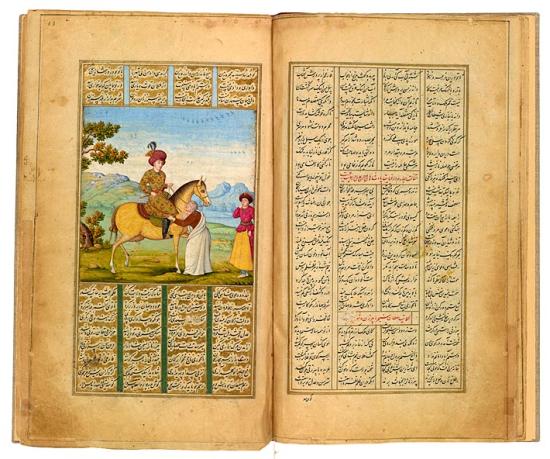Sultan Sanjar and the Old Woman

Sultan Sanjar and the Old Woman
Khamsa (Quintet), in Persian, written 1674–75 by Ghiyās al-Dīn Maḥmūd Ibn Salīm Lātī, with miniatures ca. 1700–1715 inscribed (probably erroneously) to Muḥammad Zamān and his brother Ḥājī Muḥammad.
Purchased by Pierpont Morgan, 1911
Here, to the amazement of an aide, an old woman grasps the hem of the coat of Sultan Sanjar (r. 1117–57) as he is about to go out hunting. She has come to complain of her mistreatment by the sultan's soldiers, but the Seljuq ruler tells her that the complaint is laughable when compared with his many successful conquests. "What good is it to conquer territories," she answers, "if you do not control your soldiers?"
The story is told in the fourth discourse of Niẓāmī's moralizing Makhzan al-asrār (Treasury of Secrets), the first (ca. 1175) of five long narrative poems that make up his Khamsa (Quintet). The name of the artist, Muḥammad Zamān, and the date 1086 (1675) below the old woman were probably added in error.
Persian poetry
The Persians loved their poetry and their poets, though the Qur˒an warned against believing their words (sura 69.41) and "those straying in evil who follow them" (sura 26.224). While Arabic was the first language of Islam and the language of the Qur˒an, Persian was favored by poets. Even Firdausī's (940–1020) celebrated Shāhnāma (Book of Kings), the national epic of Persian, was written in verse—some 50,000 couplets! Rūmī (1207–1273), the best known of the Sufi poets, put poetry in perspective when he wrote, "A hundred thousand books of poetry existed / Before the word of the illiterate [Prophet] they were put to shame!" (Masnavī I, 529). Presented here are illustrations of Firdausī's Shāhnāma as well as works by Sa˓ dī (ca.1184–1292), Hāfiz (ca. 1320–1389), and Jāmī (1414–1492), regarded as the last of the great Sufi poets. Also featured are illustrations from each of the five poems of the Khamsa (Quintet), by Niẓāmī (ca. 1141–1209), especially Lailā and Majnūn (The Persian Romeo and Juliet) and Bahrām Gūr's Seven Princesses.